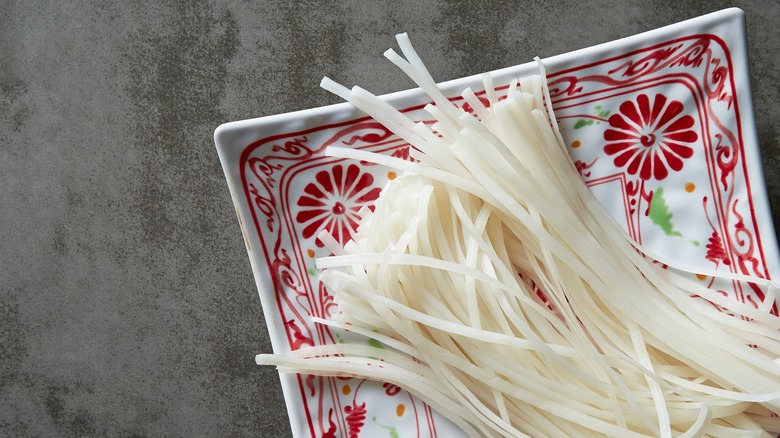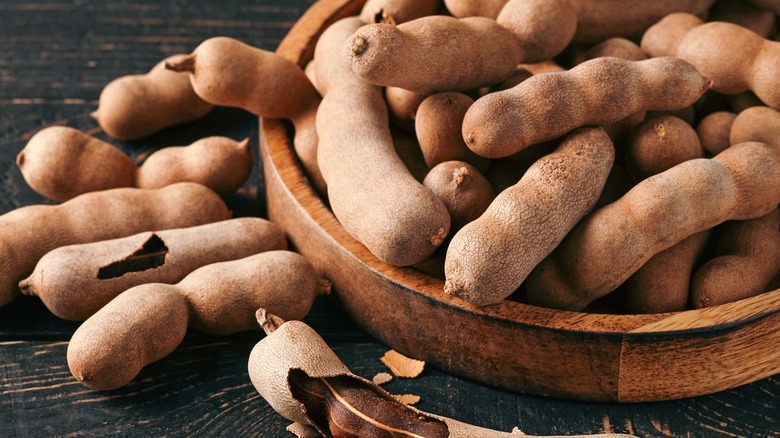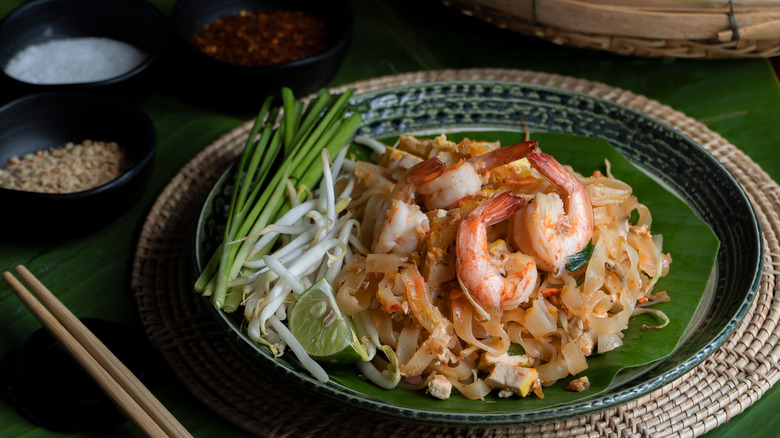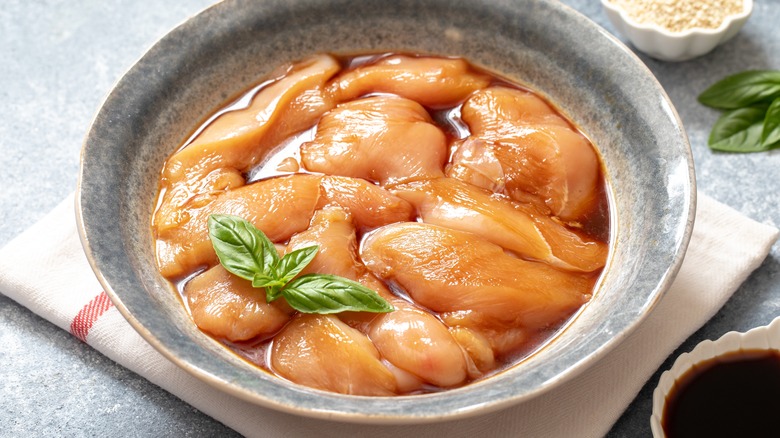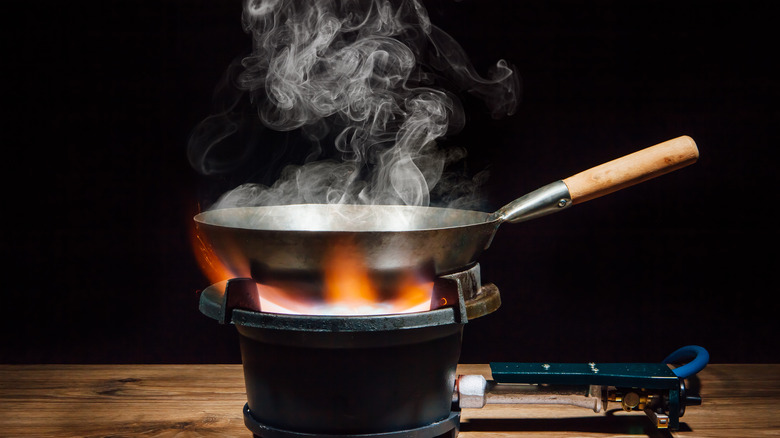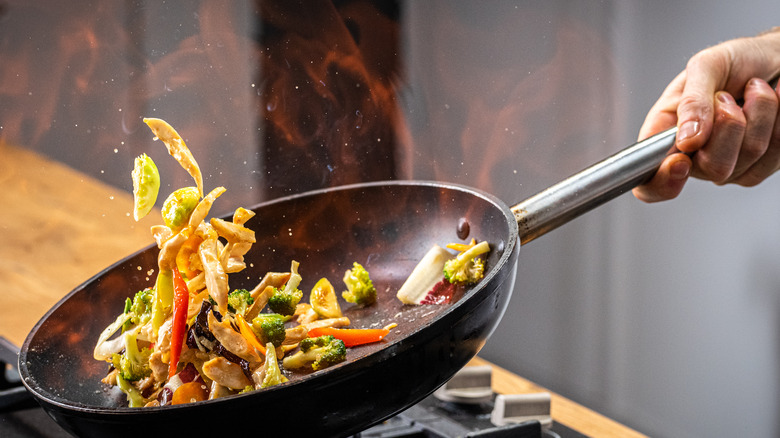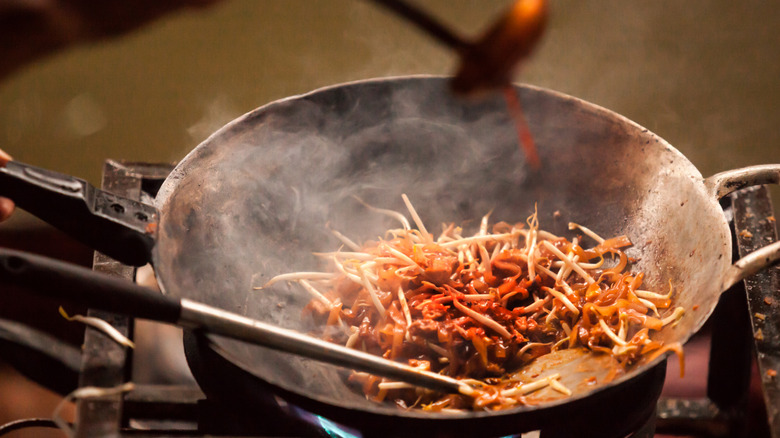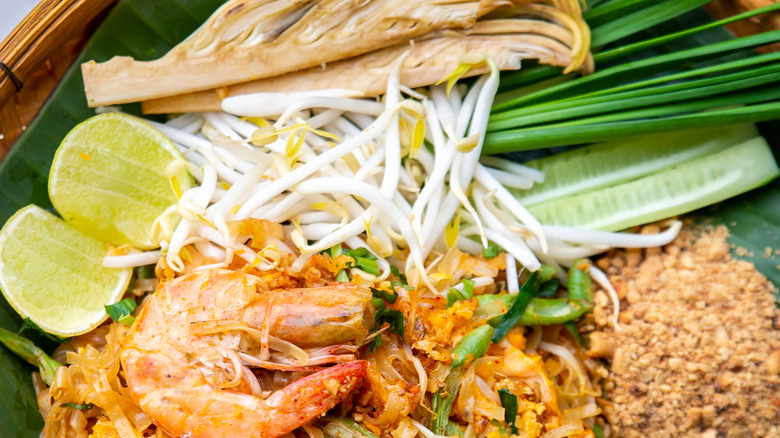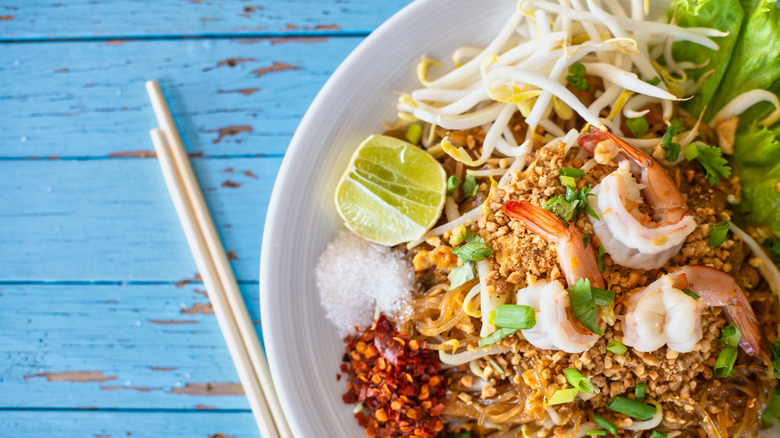17 Tips You Need To Make Restaurant-Quality Pad Thai At Home
Today, we're diving chopsticks first into Thailand's most recognized dish, pad Thai. The popularity of pad Thai is no coincidence. The dictator who gave pad Thai its name, Luang Phibunsongkhram, initiated a campaign to establish a national dish, attempting to foster a sense of ultra-nationalism. He orchestrated campaigns that provided visas to Thai chefs born abroad and distributed complimentary samples of the flavorful noodle dish with recipe cards to the local residents.
Ultimately, the advertising campaign succeeded. The world loves the umami-rich, tangy, sweet, and sour sauce that coats chewy noodles, succulent proteins, and crisp vegetables. Not forgetting the obligatory sprinkle of peanuts and beansprouts. Even though pad Thai is a quick dish — ready in less than 20 minutes — mastering the techniques and finding the ultimate depth of flavor at home is no easy task.
That's why we've reached out to a special source offering the best advice on preparing authentic restaurant-quality pad Thai in your kitchen: Mike Morales, the Executive Chef of Sunda New Asian. The acclaimed restaurant, known for its selection of pan-Asian dishes, including sushi, adobo, poke bowls, dim sum, and pad Thai, has three locations in Chicago, Nashville, and Tampa. If you can't make it to a Sunda, don't worry — these tips are everything you need to make restaurant-quality pad Thai at home.
Choose the right type of noodles
First and foremost, pad Thai is a noodle dish. Those crunchy vegetables and intensely savory sauce won't deliver the same impact without the signature noodles to cling to. Likewise, the recipe would have an entirely different texture if, in place of rice noodles, you used egg noodles, soba noodles, or ramen noodles. It would cease to be pad Thai.
Rice noodles look similar to glass noodles, but while the former is made from moong bean starch, rice noodles are, as the name suggests, made from rice. Pay close attention to the width; you want noodles labeled "rice sticks," which are flat and relatively broad, allowing the umami-packed sauce to coat them with flavor. The preferred width for pad Thai noodles, often marked on the packet, is 3 to 5 millimeters.
Soak your rice noodles, don't boil them
Few things are as disappointing as a plate of pad Thai that's turned mushy or gummy. The texture of your noodles can make or break the dish, and aside from selecting the correct variety, the second most crucial step to avoid disaster lies in how you cook your noodles. Unlike other noodles, the rice noodles used for pad Thai don't require cooking in the traditional sense. Pre-boiling or blanching the rice noodles causes excess starch to leech from the ribbons, leading to a gloopy dish — nobody wants that.
You need to soak the rice sticks in room-temperature water. Although the time varies depending on the brand and width of the noodles, a general rule of thumb is around 30 minutes, with the noodles visibly turning white, becoming pliable, and yet retaining a bite. You'll finish the cooking process in the wok, yielding a perfect al-dente, slightly chewy texture.
Select the vegetables you use carefully
The first tip from esteemed chef Mike Morales, Culinary Director of Sunda New Asian, is simple: pick the vegetables you use with thoughtful intention. For example, although bok choy is a staple in many other Thai dishes, Morales advises against the crunchy leafy vegetable for one primary reason — it's too watery. The same is true for many summer vegetables, like squash, zucchini, and spinach.
Typically, traditional pad Thai only uses a few vegetables and alliums, which help to increase the aromatic nature of the dish and provide additional texture. Among these are beansprouts, garlic chives, onions, and garlic. However, if you want to add more vibrancy to your dish, we recommend sticking to the stir-fry classics: julienned carrots, bell peppers, broccoli, green beans, baby corn, and sugar snap peas. These choices maintain their crispy texture even when stir-fried at high heat and look equally appealing to the eye.
Make the effort to source authentic ingredients
If you want your loved ones to question whether you've snuck out to the local restaurant when they taste your pad Thai, put down the readymade sauce mixes and head to your local specialty store to stock up on authentic essentials.
For example, fish sauce — known in Thailand as nam pla — adds an indescribable sweet, briny, salty flavor. There are many types of fish sauce, and the Thai variety tends to be the saltiest. Premium quality fish sauce should have a reddish tint, with a price to reflect the quality. Aside from fish sauce, another seafood condiment is crucial to that authentic taste: ground-dried shrimp. This addition intends to enhance the depth and complexity of the flavor. As opposed to the subtle sweetness of fresh shrimp, dried shrimp contribute a robust umami flavor. Vegetarians can replace the glutamate with diced shiitake mushrooms. Finally, it's worth seeking out palm sugar, a healthier alternative to white granulated sugar, with a distinctive caramel-like, smoky complexity that helps develop pad Thai's signature sweet edge.
Buy the right type of tamarind paste
Would you be surprised to know that the list of ingredients necessary to make a restaurant-quality pad Thai includes fruit? Yes — if you haven't guessed, we're talking about tamarind, a tropical tree that produces seed pods filled with sinewy pulp. India is the largest exporter of tamarind — this fact is crucial to bear in mind because, for pad Thai, it's essential to procure Thai tamarind paste specifically.
Indian tamarind paste is often highly concentrated and thick, resulting in an intensely sour, gloopy product unsuitable for making pad Thai. However, Thai tamarind paste undergoes dilution and exhibits a mild increase in sweetness while retaining its unmistakable acidic qualities. This balance is critical to achieving the typical pad Thai taste. Additionally, we recommend bypassing tamarind juice, tamarind sauce, or tamarind chutney. You can use raw tamarind, but as it involves an intensive preparation process, it's best to stick with tamarind paste.
Pick an authentic protein
Head into a Thai restaurant and find pad Thai on the menu, and you'll see two proteins that dominate the pairing options: shrimp and chicken. Of the two, you'll find shrimp pad Thai is the default option sold by Thai eateries and street vendors. Uniquely, shrimp doesn't have the same pungent fishy taste as most other seafood, instead inclining towards a mildly buttery, sweet, and salty flavor. Chicken, on the other hand, is a fantastic crowd-pleasing option. Most recipes use boneless chicken breast or thigh. You may feel tempted to cut it into chunks; we recommend finely slicing it for the best texture.
Other protein possibilities include pork and beef, which are less common but equally delicious. Extra-firm tofu is traditionally included in all varieties of pad Thai but also makes for a protein-packed solution for vegans and vegetarians; just be mindful of the fact you'll have to omit the fish sauce and switch out dried shrimp with shiitake mushrooms for plant-based tofu pad Thai.
Prep your ingredients ahead of time
Every chef, whether a seasoned professional or a novice home cook, knows the importance of food preparation. Known in French as mise en place, or literally "set up," the process refers to meticulously cutting your vegetables, garnishes, and proteins ahead of time. Once you complete that, arrange all your ingredients in small bowls, making them easily accessible.
It's tempting to skip this methodology as a home cook, but Executive Chef Mike Morales, who recently made an appearance on the Food Network show "Chopped," urges you on the importance of organized prep work. Have everything pre-cut and at hand before you heat your wok rather than cutting and tossing in ingredients as you go. Asian food, which is often fast-paced, is notably dependent on kitchen structure. When left unattended, items in a wok can quickly burn in the time it takes you to locate the ingredients you need to add next.
Try marinating your protein
Pad Thai typically features shrimp, but if you wish to substitute it with other proteins, prepare to invest some additional effort to infuse jaw-dropping flavor into your meal. While shrimp doesn't require marination, other proteins — such as chicken, pork, beef, and tofu — massively benefit from the flavor and texture changes.
Your marinade can be as simple as equal amounts of soy sauce, cornstarch, and water. This straightforward combination of ingredients will tenderize the protein, coating it in extra layers of flavor. The umami-rich soy sauce will draw those savory, intensely meaty flavors to the forefront. For ultra-flavorful chicken and other proteins, we recommend using a fork and pricking your protein, so the marinade can saturate through the entire thing. Making slashes on the surface will help, too. Because this isn't a traditional marinade, you don't need to let it sit for so long; we recommend letting it aromatize while you soak your noodles and prep all the other ingredients.
Use a well-seasoned wok
Mike Morales, the Executive Chef and Culinary Director at Sunda New Asian, knows how woks are used across the three restaurant locations he oversees. So, when he emphasized the significance of a well-seasoned wok for pad Thai, you can be sure we paid close attention.
To season a new wok, wash it and then heat it over high until smoking, rotating and turning when needed until each side of it is evenly warmed. Cool the pan, rub oil over the surface with a paper towel, then heat it again. Once coated, cool and repeat the process. You'll need to rinse your pan in water, then re-coat with oil each time you cook with it in the future.
Seasoning has two fundamental purposes: making the surface non-stick and infusing flavor into your food. Both have non-obvious consequences, such as a seasoned wok creating even heat-dispersal and a glorious sear, which will naturally impart more savory flavor into your dishes.
Master the wok hei technique
If you're well versed in Asian cuisine, you may have heard of the wok hei technique, literally meaning "the breath of the wok." It refers to the remarkable charred, smoky aroma that food seared over high temperatures attain, and it's the benchmark for a really great pad Thai.
The first step toward harnessing the full potential of wok hei in your pad Thai is using a hot wok and high smoke point oil. Unlike Western cooking schools, wok-cooking dictates that you heat your wok until smoking, then add cold oil to create a non-stick surface.
Second, you need to maintain that heat throughout the cooking process — this can be tricky, as home burners can't reach the same burning heat as commercial kitchens. To ensure we preserve that heat, avoid overcrowding and constantly rotate the ingredients. The combination of sizzling heat and controlled tossing will guarantee the ingredients lock in their natural flavors while adding a smoky depth to the dish that no other technique can match.
Don't stir the pad Thai while cooking
While we're all used to the phrase "stir constantly," this adage couldn't be further from the truth when cooking with a wok, especially with a dish like pad Thai. Stirring the ingredients in your wok too often will likely cause you to break your delicate noodles and make it challenging to mix everything evenly. You should be sure to cook your vegetables and protein for longer than your noodles by waiting to add the soaked noodles until the produce has softened and formed char marks.
You've likely witnessed professional stir-fry chefs tossing ingredients into the air. If you want to give this a go, hold your wok handle in one hand, grip the spatula with the other, and simultaneously push the wok and spatula away from your body, then bring it back towards you, creating a tossing motion. If this feels too intimidating, practice a tossing action with the spatula alone; scoop the ingredients up, then flip back down. Maintaining the balance between char and caramelization for flavor and evenly cooked ingredients is critical.
Stop crowding your wok
While a recipe can lead you to delicious flavored pad Thai, achieving the right texture of crunchy vegetables, succulent protein, and chewy noodles relies on techniques, a topic that brief recipes typically don't delve into. There's a frequently overlooked element to ensuring your pad Thai attains that restaurant-quality standard we all strive for — using the right sized wok.
Even though a wok may seem spacious at first glance, it's important to note that the round bottom, where most of the heat concentrates, is relatively small. This unique design requires a tossing method to ensure even cooking. When you overcrowd your wok, it becomes challenging for everything to cook uniformly, and more significantly, the excess moisture in your ingredients, such as vegetables and noodles, struggles to evaporate, resulting in a mushy texture. To prevent this problem, it's essential to take into account the number of servings you intend to prepare and choose a wok size based on your usual portions.
Balance the sweet, sour, salty, and spicy flavor
Classic pad Thai stands out from other noodle stir-fry dishes primarily due to its signature sauce, which famously combines the primary tastes: sweet, sour, salty, spicy, and umami. If any of these are missing, or the ratios are incorrect, you'll fall short of the restaurant-quality pad Thai plate you've been aspiring toward.
The sweet aspect is complex, with palm sugar forming the base flavor notes of caramel, maple, and butterscotch. Other ingredients, such as tamarind, also offer undertones of fruity sweetness. Tamarind is also the leading source of pad Thai's hallmark sourness, which adds tart brightness and helps to cut through the sweet and spicy notes. Lime juice — which we squeeze on after serving — adds depth with a citrusy tang. Saltiness, contributed by fish sauce and soy sauce, provides depth and umami, while spiciness from fresh chilis imparts a fiery kick. Be careful not to miss any of these ingredients, or your dish will lack the desired rounded balance.
Skip the ketchup
There's a good chance you've eaten a few substandard plates of pad Thai in your time. One thing they likely have in common is a peculiar red tint to the sauce-coated noodles. The culprit? Ketchup. It's an ingredient traditional pad Thai doesn't use, though somehow, it has ended up in Western mock-ups.
Admittedly, ketchup offers much of the flavors combined in pad Thai — sweet, tangy, and with natural umami from tomatoes. However, it's no substitute for authentic ingredients and can't conjure the same depth of sophisticated and nuanced flavor. And using it to make the dish look a more appealing color, as many restaurants do, is unnecessary. Instead, whisk up a straightforward and authentic sauce by combining Thai tamarind paste with palm sugar, dark soy sauce, sweet soy sauce, and fish sauce. Other aromatics you can optionally include are fresh red chili peppers or ground white peppercorns.
Scramble the egg near the end of cooking
Unless you're cooking up a one-pot, throw-it-together meal, the order you add ingredients to a dish is vital. Cooking in a wok amplifies this; some ingredients are flash-fried and ready in less than a minute.
Apart from the primary protein, pad Thai typically includes two secondary proteins: eggs and tofu. One of the biggest mistakes of cooking stir fry — including pad Thai — is scrambling the egg at the beginning and leaving it in the pan with the other ingredients. Unfortunately, this method results in overcooked, rubbery eggs lacking that gorgeous buttery softness we look for.
Instead, as one of the most delicate components, add your eggs directly to the pan after coating your noodles with the sauce. There should be ample space in your wok to push the noodles to the side, introduce the eggs, and gently fold them together to create fluffy scrambled eggs. For optimal results, incorporate them into the noodles before they are fully set and before adding your final ingredients: beansprouts, garlic chives, and the pre-cooked primary protein.
Add freshness with garlic chives
We've all heard of green onions (scallions), spring onions (the sweeter, more bulbous sister of green onions), and chives. But what about garlic chives? Otherwise known as Chinese chives, this long green allium is well-known for its use in Asian cuisine. Chinese chefs have been cooking with the shoots for over 5,000 years — hence the name — but the chives are also eaten throughout Southeast Asian countries, including Thailand.
When it comes to flavor, garlic chives have a distinct profile. Unlike their allium counterparts, Chinese chives have a punchy, vibrant, garlicky flavor on top of the usual mild onion undertones. We advise adding the shoots at the end of cooking to maintain their beautiful green color and unique aroma. It adds much-needed freshness to the dish and enhances the natural balance of flavors as well as colors. If you're anything like us, you've been guilty of using scallions in place of garlic chives — but undoubtedly, it's worth seeking out this authentic ingredient.
Never skip the garnishes
Elevating your homemade pad Thai to restaurant quality is not just about nailing the core recipe — once you plate your noodles, a sprinkle of garnishes can make all the difference. Start with the basics: finely chopped peanuts, fresh bean sprouts, and a wedge of lime. They add texture, crunch, and a fresh citrus that balances richer flavors and brings brightness to the forefront. Then, consider a sprinkle of chopped cilantro to complete the citrusy flavors or finely sliced green onion to amplify the mild, sweet undertones. If you have diners who love the fiery burn of spice, scatter chili flakes or freshly chopped bird's eye chilis over the saucy noodles.
Finally, street vendors in Thailand often finish the plate with an unusual ingredient: banana blossoms. The fleshy flower, which grows at the end of banana trees, has a nutty flavor reminiscent of artichokes, with a bitter tinge when eaten raw. Cut a wedge, rub it with salt and lime juice to neutralize the bitterness, and eat the flaky side alongside your pad Thai.


